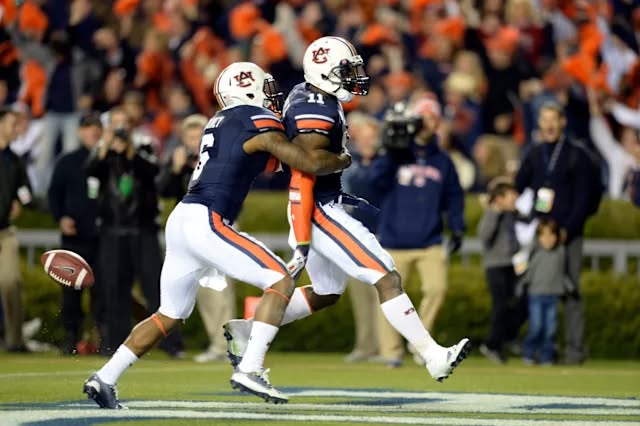In the world of college football, where tradition and passion collide every fall Saturday, few plays have etched themselves into the collective memory of fans with as much drama and spectacle as Auburn’s legendary “Kick Six.” The final play of the 2013 Iron Bowl between Auburn and Alabama not only decided a game—it altered the course of a season, shook the foundations of a dynasty, and instantly became one of the most iconic moments in sports history. That’s why ESPN, in its rankings of the greatest plays since 2000, considers the “Kick Six” among the top, not just for the shock and thrill it delivered, but for the legacy it has carried forward over the years.
The “Kick Six” took place on November 30, 2013, at Jordan-Hare Stadium in Auburn, Alabama. The stakes could not have been higher. Alabama, led by legendary head coach Nick Saban, entered the game as the two-time defending national champion and was ranked No. 1 in the country. Auburn, coached by Gus Malzahn and in the midst of a miraculous season turnaround, was ranked No. 4. A win for either team meant a spot in the SEC Championship and a likely berth in the BCS National Championship Game. The 78th Iron Bowl was already steeped in tradition and rivalry, but this installment carried unprecedented weight.
With the game tied at 28-28 and only one second left on the clock, Alabama had the ball near midfield. Rather than kneel and play for overtime, Nick Saban made a decision that would become the centerpiece of the legend: he sent out freshman kicker Adam Griffith to attempt a 57-yard field goal. While the distance was daunting, Saban believed that the opportunity to win outright in regulation was worth the gamble. The previous kicker, Cade Foster, had missed three field goals earlier in the game, and Saban opted for the untested Griffith, whose leg strength was more suited for the distance.
The decision set the stage for what would become one of the most breathtaking endings in the history of college football. As Griffith lined up for the kick, Auburn’s Chris Davis, a senior cornerback and return specialist, was positioned deep in the end zone, prepared for a possible return in case the kick fell short. It was a precautionary move, one most teams rarely consider in such situations—but it turned out to be brilliant.
Griffith’s kick had the distance, but it began to drift and ultimately fell just short of the crossbar. Davis, standing at the very back of the end zone, caught the ball and began running. What followed was a blur of movement and sound—a kaleidoscope of disbelief and euphoria that would define Auburn football forever. Davis weaved through the initial wave of would-be tacklers, picked up blockers along the sideline, and sprinted 109 yards to the opposite end zone. Time expired as he crossed the goal line. The stadium exploded.
In a moment, the game was over. Auburn had won, 34-28. Fans rushed the field in a wave of orange and blue. Broadcasters screamed in disbelief. Alabama players stood stunned, unable to process what had just occurred. A game that had seemed destined for overtime ended in the most improbable, unthinkable way. It wasn’t just a great play; it was history.
The implications of the play were massive. With the win, Auburn moved on to the SEC Championship, where they defeated Missouri. That victory propelled them to the BCS National Championship Game, where they narrowly lost to Florida State in a game that also went down to the wire. Alabama, on the other hand, saw its hopes for a third consecutive national title vanish in a moment. The “Kick Six” not only delivered an epic win for Auburn—it disrupted the college football hierarchy and added another dramatic chapter to one of the sport’s most storied rivalries.
What makes the “Kick Six” so special is not just the outcome, but everything it represents. It was a rare combination of athleticism, strategy, and split-second decision-making. Davis’s awareness and speed were unmatched; his path to the end zone was a masterclass in vision and execution. But equally crucial was Auburn’s preparation—Malzahn’s coaching staff had practiced defending long field goals in such scenarios, and the team knew exactly what to do. The moment was not pure luck; it was the product of preparation meeting opportunity in the most dramatic fashion imaginable.
The reaction to the play was immediate and far-reaching. Within minutes, highlights of the return flooded social media and sports broadcasts. Fans and analysts alike scrambled to process what had just occurred. ESPN featured the return on every platform, and the clip became one of the most-viewed sports videos of the year. For days—and even years—afterward, it was played and replayed as the ultimate example of a game-ending, jaw-dropping moment. It transcended regional rivalries and appealed to every sports fan who loves the unpredictability and thrill of competition.
In the years since, the “Kick Six” has been studied, analyzed, and mythologized. It’s been the subject of documentaries, detailed breakdowns, and countless fan tributes. Auburn has commemorated the moment with murals, highlight reels, and even merchandise. The play is shown to recruits, celebrated at reunions, and remains a staple of any discussion about great college football moments.
But beyond the glory and the highlight reels, the “Kick Six” speaks to something deeper in the culture of sports. It reminds us why we watch. For all the hours of predictable outcomes and routine plays, there’s always the possibility—however small—that something truly extraordinary might happen. The “Kick Six” was that rare, electrifying moment where everything changed in an instant. It was a perfect storm of high stakes, bitter rivalry, and dramatic execution, all wrapped in the lore of college football’s most intense rivalry.
It also symbolizes the fine line between victory and defeat, between immortality and heartbreak. For Alabama fans, the play is a painful memory, a reminder of how quickly dominance can be upended. For Auburn fans, it is the epitome of triumph, a moment to relive again and again, a touchstone of pride and identity. Rivalries are made of these moments—not just wins and losses, but unforgettable snapshots in time that shape how teams and fans see themselves.
ESPN’s decision to rank the “Kick Six” among its top plays since 2000 is more than justified. In terms of excitement, the play delivered on every level. The tension of a tie game, the audacity of a long field goal attempt, and the shock of a return touchdown combined for unparalleled drama. Its significance is unquestionable—the play impacted the national championship picture and altered the legacies of both teams involved. And in terms of being unforgettable, few plays have seared themselves into the public imagination quite like this one. Even those who don’t follow college football know the term “Kick Six.”
For ESPN, whose role in shaping sports culture over the past few decades has been massive, recognizing the “Kick Six” is an acknowledgment of what makes sports great. It isn’t just about stats and records—it’s about moments. Moments that fans remember where they were when they happened. Moments that bring strangers together in awe. Moments that, years later, still send chills down your spine.
The 2013 Iron Bowl was already poised to be special, but the “Kick Six” elevated it to legendary status. It turned Chris Davis into a household name. It added another layer of drama to the Iron Bowl, a rivalry that needs no help in producing intensity. And it became a benchmark against which all other game-ending plays are measured. You don’t just make a great play—you hope to make something like the “Kick Six.”
It’s easy to imagine future generations watching the highlight and marveling at the audacity of it all. A missed field goal turning into a game-winning touchdown is the kind of thing that belongs in movies or folklore, not in real life. But it happened. It’s real. And it’s one of the reasons why college football holds such a special place in American sports culture.
As the years go by, the legend of the “Kick Six” will only grow. New fans will discover it. Old fans will never forget it. And every Iron Bowl, it will be remembered, discussed, and replayed. In a game that has produced countless memorable moments, this one stands alone. The “Kick Six” is not just a top play—it is the play. A flash of brilliance that captured the spirit of the sport and left an indelible mark on college football history.



